Purchasing a horse should be well planned and carefully thought out. For most people, this will be a significant investment and therefore it should not be handled in a rushed manner. The cost of horse ownership does not stop when the animal is purchased. It is important to plan for daily nutritional needs, facilities, veterinary expenses, farrier services, tack and riding equipment, transporting equipment, and the time commitment that horse ownership requires. Once you have completed the planning process, exercising patience, defining your selection criteria, and avoiding high-pressure or impulsive buying situations will result in more positive results and set you up for an enjoyable horse owning experience.
The best way to buy a horse is to locate an honest seller. Many breed associations will make referrals that can help with this task, and it is also advised to visit with other horse owners and veterinarians in your area. When evaluating a horse for purchasing, it is a good idea to take along an experienced person to help you. A second set of “trained” eyes can be invaluable when examining a potential purchase. If possible, take the horse on a trial basis to see if it is going to be a good fit. A horse that works well for someone else may not necessarily work well for you.
Learn as much as you can about horses
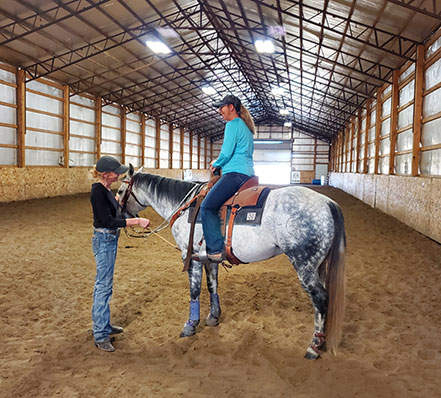
Prospective horse owners should learn all they can about horses before buying. Information is available at University of Missouri Extension Centers, breed associations, libraries, bookstores, and on the internet. Trusted internet sources include cooperative extension service websites, research institutions, and breed associations. Inexperienced riders should seek out clinicians and take riding lessons. Most experienced horse owners are willing to share their knowledge with beginners so do not be afraid to ask questions.
How much can you afford?
Determining how much you can afford to pay for a horse and spend on daily care is essential. Prices for horses have risen significantly over the past few years. As a result, many prospective buyers may experience “sticker shock” when they begin their horse buying journey. If short on funding, it is typically better to save up funds rather than settle for a less expensive horse that may not meet the buyer’s selection criteria. The table below can be used to help develop a horse ownership budget.
Table 1. Horse Ownership Expense Planner.
| Suggested ranges | Your estimate | |
|---|---|---|
| Facilities/Boarding | $200-700/month | |
| Feed | $0-90/month | |
| Hay | $0-150/month | |
| Farrier (Every 6-12 weeks) | $40-50 (trims) $85-150 (full set of shoes) |
|
| Veterinary Services | $40-100/year (vaccinations) $20-40/year (Coggins test for Equine Infectious Anemia) $100-150 (dental care, examine annually and follow recommendations) |
|
| Tack | Varies widely by budget and discipline | |
| Insurance | 2.5-4.5% of purchase price/year (mortality) $300-800/year (medical) |
|
| Total |
Consider facilities
Many families are leaving urban areas and are relocating to suburban or rural ones. For some, part of the reasoning is the desire to purchase a small acreage and experience the rural lifestyle and horse ownership. It is important before purchasing acreage to make sure that there are no zoning laws or county health ordinances in place that would limit or restrict livestock ownership or even the construction of barns to house animals. Adequate housing is also necessary to properly care for a horse. If new facilities are needed, they can be expensive to build, and maintenance and depreciation costs should be considered. There are many different options for fencing and the costs vary considerably. One fencing type that is discouraged is barbed wire. In some ways horses are very hardy animals, but in others they are extremely fragile. Horses can be prone to accidents and cuts from barbed wire fences can be dangerous and even crippling.
For those who live in urban areas and are considering purchasing a horse, boarding stables, if available, may be the best or only option for housing. Boarding expenses vary depending on the level of care, services and facilities provided. More expensive levels of care would include daily stall cleaning, feeding, exercising and even pasture turn out time. Less expensive boarding might simply be pasture with access to a shelter. Each boarding facility decides what type of care option they will offer but some that are often available are:
- Full-care board = Feeding, watering, cleaning of stall or pen, blanketing, and pasture or dry lot turnout is done by stable employees. Feed, hay, and stall bedding are often included in a single fee for the horse owner.
- Self-care board = Feeding, watering, cleaning stall or pen, blanketing, and turnout is the horse owner’s responsibility. The stable or pasture owner is usually only providing the facility. The horse owner supplies all feed, hay, and bedding in this scenario.
- Partial-care board = Some facilities may offer this as an intermediate option between full-care and self-care board. For example, stable personnel may feed once a day with the owner responsible for feeding the other time.
Horse owners or veterinarians in your area may be able to supply recommendations for boarding facilities. Having a boarding contract in writing may help avoid any potential headaches.
What age of horse is best to purchase?
The age of the horse you should buy depends on your experience level and intended purposes. Generally, an inexperienced rider should be paired with an experienced horse whereas young, inexperienced horses require more experienced riders.
Most experts agree the prime age of horses is between 7 and 15 years of age. However, horses are frequently active into their twenties if they get proper care. These older horses have a great deal to offer to new horse owners of all ages. They can teach them how to ride, be better horsemen and set them up to move onto a younger horse eventually. There is some concern with soundness issues in older horses such as navicular, ringbone, and arthritis. Many older, seasoned horses need maintenance through joint injections, chiropractic work, corrective shoeing, and joint supplements to stay comfortable and sound. These horses can be good choices for beginner riders if the owner is willing to support the horse’s needs.
This is where a veterinarian’s exam to identify any soundness or health problems comes into play. Soundness issues are not just a concern with older horses. For example, many performance disciplines are starting colts and showing them at younger ages. Many of these colts cannot stand up to the strain of this accelerated training and develop soundness issues prematurely. When this is discovered, they are often removed from intense training and sold, potentially without disclosure of the soundness issue.
How will the horse be used and who will use it?
For an owner to be satisfied with a horse long-term, they should choose a horse capable of the desired riding discipline and performing at the caliber the rider wants. A horse selected for pleasure trail riding will be quite different from one chosen for competitive riding in shows or contests.
The age, size, sex, training, and breed of the horse must be aligned with what it will be expected to do and who will be riding it. There are 20 or more different purebred horse breeds in the United States. They differ in size, shape, color, disposition, conformation, and ability. Although there are exceptions to almost any statement, it is seldom practical to select an individual horse to perform a duty not characteristic of its breed. Few horses can do everything, and certain types may be better at particular tasks than others. For example, if you want to compete in rodeo events and also raise a foal, the horse must be a mare with some training in rodeo events.
The horse and rider’s size should be considered. Small children find tall horses difficult to saddle and mount. Small horses should not be asked to carry heavy riders and equipment. It is typically recommended that a rider’s weight should be 20% or less of the horse’s weight.
What sex of horse should you buy?
For steady dependability, a gelding (castrated male) excels. Some mares (females) can be temperamental. However, some people prefer mares because the mare can be used for breeding purposes after its riding career. Stallions (intact males) are generally unsatisfactory as pleasure horses and can be dangerous when handled, even by experienced horsemen.
Do you want a registered horse?
Registered horses are recorded in a breed association and come with a registration certificate that identifies pedigree and previous ownership. A registered horse may enter both breed and non-breed specific classes in competition, whereas an unregistered (grade) horse is restricted to non-breed specific events. Registered horses usually have a higher resale value than unregistered horses, but they also tend to be more expensive to purchase. Registration papers do not guarantee that a horse has better conformation, disposition, or training than a grade horse. Grade horses are unregistered with a breed association, however, may be registrable with color or discipline related associations.
When examining a registered horse, ask to see its registration certificate. Check the papers carefully, making sure the description fits the horse you are considering. Ownership transfers must be up-to-date and signed. After purchasing a registered horse, you must send the registration papers, the signed transfer paper, and appropriate transfer fees to the specific breed association to have the horse recorded in your name.
Where to get a horse
The most common sources of horses are breeders, private sales, dealers or traders, and auctions.
Breeders
Buying privately from a breeder may be the safest way to get a horse, especially if you are wanting a young horse. Most horses on a breeding farm will be breeding stock or young horses with little to no training. Therefore, if you want to purchase a mature riding horse, they may not have what you are looking for. A breeding program takes years to develop, and many have a loyal following of customers. While a breeder may not have the specific type of horse you are looking for, chances are that one of their customers may have the perfect match for you. Lists of breeders are available from state and national breed associations, most of which have websites.
Private sales
As a rule, buying from a private owner results in greater success than buying from a dealer or at an auction. Often circumstances such as moving, children losing interest or attending college, or financial constraints necessitate the sale of good horses. It is ideal to obtain a bill of sale with signatures from both buyer and seller and a description of the horse for private sale purchases.
Dealers or traders
Buying from a dealer requires horse knowledge. A horse dealer makes money buying and selling horses. Some dealers are honest and handle high caliber horses but, unfortunately, some are not. Learn what you can about a specific dealer before buying. Check with horse owners who are acquainted with the dealer. Good dealers have good reputations and are willing to stand behind their sales. Understand that with the high cost of feeding and maintaining horses, many dealers may not own the horse very long before listing it for sale. This means they may not know much about the horse’s history, training, or soundness.
Auctions
In general, buying at auctions can be risky. Do not assume all sellers are honest. There are several different types including monthly sale barn, consignment catalog, breed association, internet, and even event specific auctions such as “roping horse only” sales. Usually at an auction, no guarantees are made, and horses cannot be returned or exchanged. However, in recent years some auctions have started offering guarantees and even give the purchaser a specified amount of time to try the horse and return it for a full refund if the animal is not as presented. If you are considering purchasing a horse at an auction, look for one that offers these guarantees.
Have a vet check performed on prospective horses
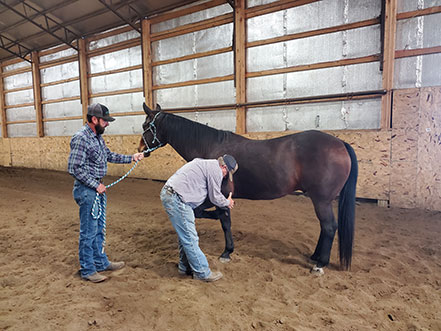

It is recommended to only purchase a horse once it has passed a veterinarian’s examination. This is most often conducted at the buyer’s expense. At minimum, a vet check should include tests for general health, vision, dental health, hoof health and soundness. For performance horses, you may want to consider having the veterinarian take and evaluate x-rays of the horse’s legs and hooves. Some purchasers may also choose to have the veterinarian draw a vial of blood to keep on file for testing if the horse’s health, soundness, or temperament changes significantly after purchasing.
Pre-purchase exams can include a flexion test to evaluate potential limb lameness more easily. During flexion tests the veterinarian stresses the joints in the horse’s leg by bending and holding the leg for up to 60 seconds, placing it on the ground, and then immediately having the handler trot the horse off in a straight line away from the veterinarian.
The veterinarian evaluates the horse’s gait and assigns a number from 0 to 5 as a lameness score. The American Association of Equine Practitioners describes the lameness scores as:

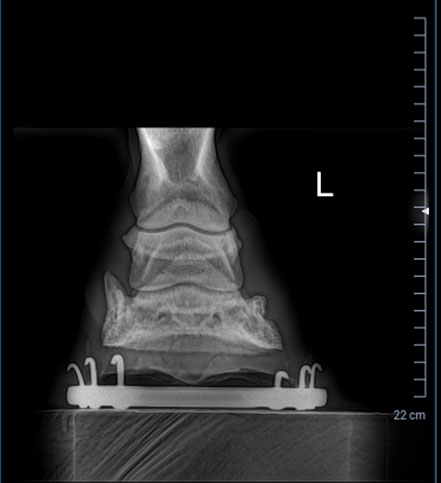
- 0: Lameness not perceptible under any circumstances.
- 1: Lameness is difficult to observe and is not consistently apparent, regardless of circumstances (e.g. under saddle, circling, inclines, hard surface, etc.).
- 2: Lameness is difficult to observe at a walk or when trotting in a straight line but consistently apparent under certain circumstances (e.g. weight-carrying, circling, inclines, hard surface, etc.).
- 3: Lameness is consistently observable at a trot under all circumstances.
- 4: Lameness is obvious at a walk.
- 5: Lameness produces minimal weight bearing in motion and/or at rest or a complete inability to move.
More information on lameness exams can be found at: https://aaep.org/horsehealth/lameness-exams-evaluating-lame-horse.
Veterinarians can take x-rays of major joints that would affect performance and soundness like the stifles, hocks, knees, fetlocks, and pasterns. X-rays give the veterinarian the ability to identify osteoarthritis, bone spurs, cartilage wear, fractures, infection, and fusion of joints that could be present, limiting the horse’s ability to perform.
Evaluating a horse in person
Once you have located a horse for sale and decide to go look, there are a number of things to observe and evaluate on site.
Check the horse in its stall
Most of the focus when viewing a horse for purchase is on the riding component. However, much can be learned about a horse by observing its behavior in the stall. There are many stalling vices that may be a deal breaker for the purchaser.
Poor temperament or barn sour
Watch the horse as you enter the stable. A horse that lays back its ears when approached may be bad tempered, spoiled, or barn sour. Barn sour horses are very reluctant to leave the barn and in extreme cases may balk, rear, buck or even run back to the barn if ridden by novice riders. If the horse shows interest and its ears are up, this is a good sign. Horses have very good hearing and should be interested in everything that goes on around them. When entering the stall, the horse should go to the rear, turn, face you, and stand quietly. If it turns away from you, it may kick. If it has been properly trained, it should be easy to catch, its ears should reflect no fear or mistrust, and the seller should have no reason to hesitate in entering the stall.
Bedding issues
Examine the bedding in the stall. Is there any indication that the horse has been eating it? Eating bedding is a bad habit and could make a horse more prone to colic (a broad term for gastrointestinal issues that can be life threatening). It also makes feeding difficult because such horses tend to fill up on bedding that has little nutritional value. Has this horse been bedded with a different type of bedding than the other horses in the barn? If bedded differently, the horse may have heaves (a chronic respiratory condition) or an allergy to certain types of bedding. Ask why they are bedded differently.
Nervous habits
Is there a path around the edge of the stall? If so, this might be an indication that the horse is a stall walker. Stall walkers will continuously walk the perimeter of the stall or pen throughout the day. Stall weavers are somewhat similar with the exception that they will stand in one spot and sway back and forth continuously. Cribbers will bite on any hard surface, pull back, and draw air into their lungs repeatedly. This vice is easy to identify on wood stalls or fences as the horse will wear down the boards during this process. These bad habits arise from nervousness and boredom. Horses that possess these behaviors are hard to cure and hard to keep in good condition.
Health records
Ask the seller for the horse’s health records. The horse should be current on vaccinations, dental work, de-worming, and hoof care. It is also recommended that the horse have a negative Coggins test (the test for Equine Infectious Anemia). Examine the horse’s overall appearance as an indication of health. The hair coat should be shiny, eyes should be clear and bright, and the hooves should be sturdy and strong. Some horses may have metabolic disorders that prevent them from shedding their hair coats properly. Be alert for runny nasal discharge and listen for coughing which could indicate a horse has a respiratory infection.
Conformation
Conformation refers to the physical shape and balance of component parts. Good conformation increases the probability that a horse can perform the functions characteristic of its breed for a long time without becoming unsound, but it is not a guarantee. “Faulty” conformation may impair some activities and may predispose a horse to unsoundness.
Although horses vary in size by breed from 200 to 2,000 pounds, some characteristics of good conformation are common to all of them. Evaluating horse conformation can take years of training and experience. When buying a horse, here are some tips on what to look for:
- Head: Wide between the eyes, short from eye to muzzle, large nostrils and eyes, and short ears are preferred.
- Neck: Clean throat latch and a long, refined neck that ties high into the shoulder is ideal.
- Shoulder: The shoulder should be long and sloping with a 45° angle.
- Back: Ideally, it should be short, strong, and level from wither to hip. The wither should be prominent enough to hold a saddle in place.
- Hip: Like the shoulder, the hip should be long and sloping with a 45° angle.
To help identify the anatomical parts of the horse, see Figure 4.
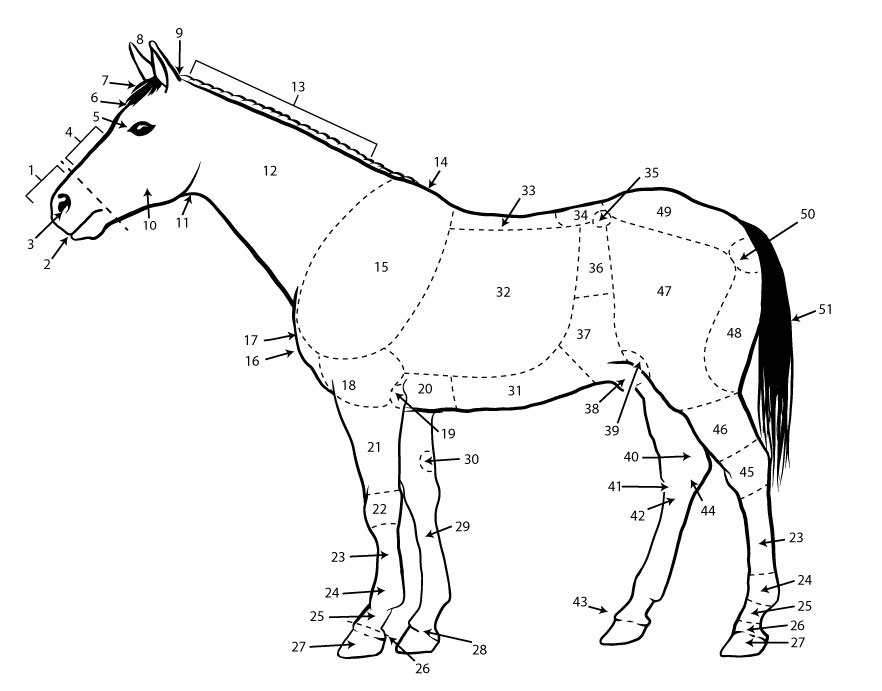
1. Muzzle
2. Lips
3. Nostril
4. Face
5. Eye
6. Forehead
7. Foretop
8. Ears
9. Poll
10. Jaw
11. Throatlatch
12. Neck
13. Crest
14. Withers
15. Shoulder
16. Breast
17. Point of shoulder
18. Arm
19. Elbow
20. Fore flank; heart girth
21. Forearm
22. Knee
23. Cannon
24. Fetlock joint
25. Pastern
26. Coronet
27. Hoof
28. Seat of sidebone
29. Seat of splint
30. Chestnut
31. Abdomen
32. Ribs
33. Back
34. Loin
35. Point of hip
36. Coupling
37. Hind flank
38. Sheath
39. Stifle joint
40. Seat of thoroughpin
41. Seat of bog spavin
42. Seat of bone spavin
43. Seat of ringbone
44. Seat of curb
45. Hock
46. Gaskin
47. Thigh
48. Quarter
49. Croup
50. Point of buttock
51. Tail
Feet, legs and movement
Observe the horse carefully as it is led from the stall. Pay particular attention to the feet and legs. Look for indications of limping, stiffness, or the favoring of a leg or foot. Look and feel for any swelling or heat in the legs. Any problem with a foot or leg is enough reason to not purchase the horse.
Make sure the legs are straight, see Figures 5 and 6. Cannon bones (bone that runs between the knee and fetlock joint) should be set squarely below a flat knee. Tendons should be well defined. Fetlocks (the joints between the knee and hoof) must be strong. Pasterns (area between the fetlock and the hoof) should be directly below the cannon when viewed from the front. The pasterns should slope and not be straight when viewed from the side.
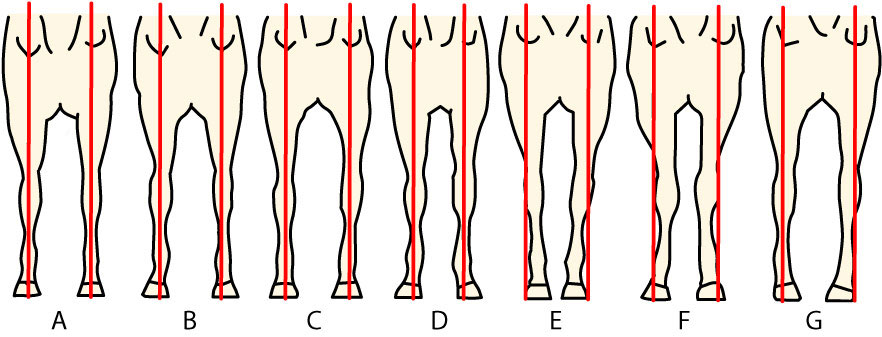
A. Ideal position
B. Toes out
C. Bow-legged
D. Narrow-chested; toes out
E. Base narrow; stands close
F. Knock-kneed
G. Pigeon-toed
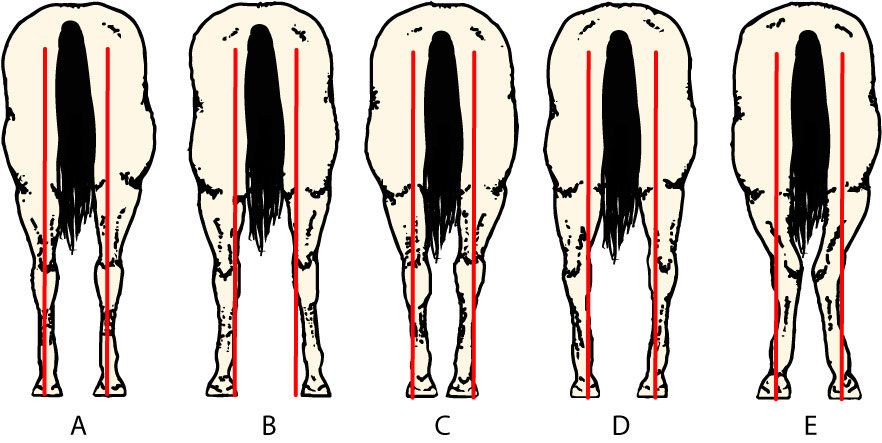
A. Ideal position
B. Stands wide
C. Stands close
D. Bow-legged
E. Cow-hocked
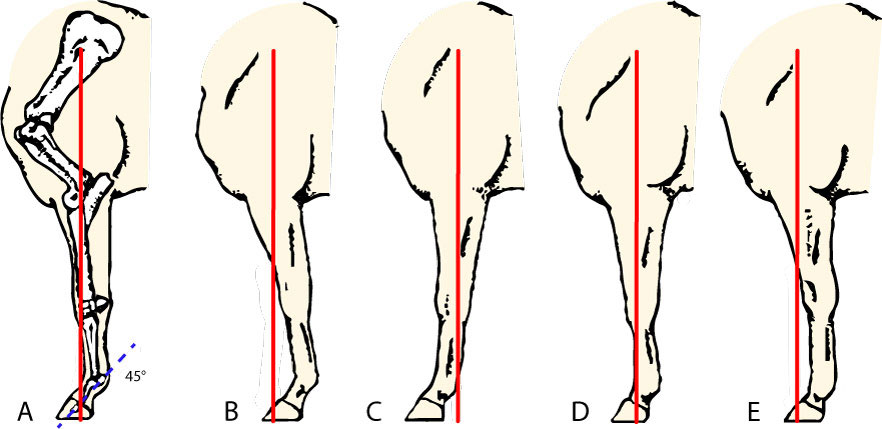
A. Ideal position
B. Camped-under
C. Camped-out
D. Knee sprung
E. Calf-kneed
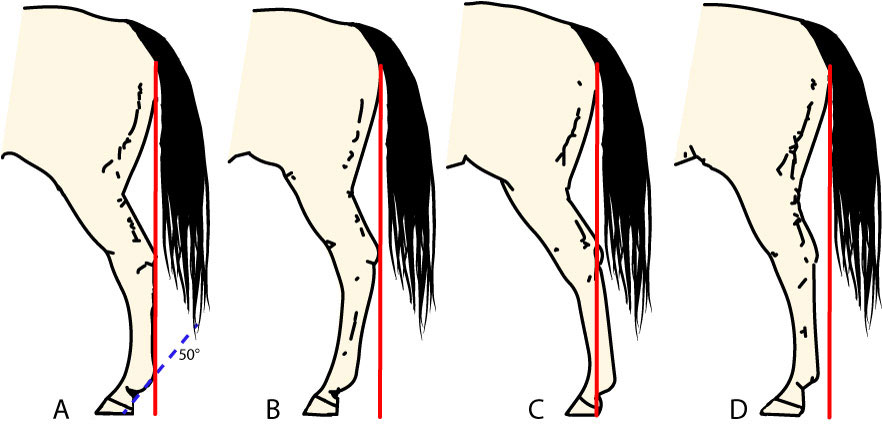
A. Ideal position
B. Stands under
C. Camped-out
D. Leg too straight
A sound horse walks correctly from the first step. Some unsound horses will appear sound after being warmed up. Look closely at the fetlocks, pasterns, and hocks. Any swelling in these areas should provoke serious doubts about soundness. When evaluating at the walk and trot, lameness in a front limb can be indicated by a nod of the head when weight is placed on the sound limb. The croup may drop when weight is shifted from a lame hind limb to a sound one. Pain in a front limb may be noticeable in a standing position by pointing (resting one front foot ahead of the other). Figure 7 will help you to identify potential problems like ring bone, side bones, bone spavins, curbs, splints, and foundered hooves.
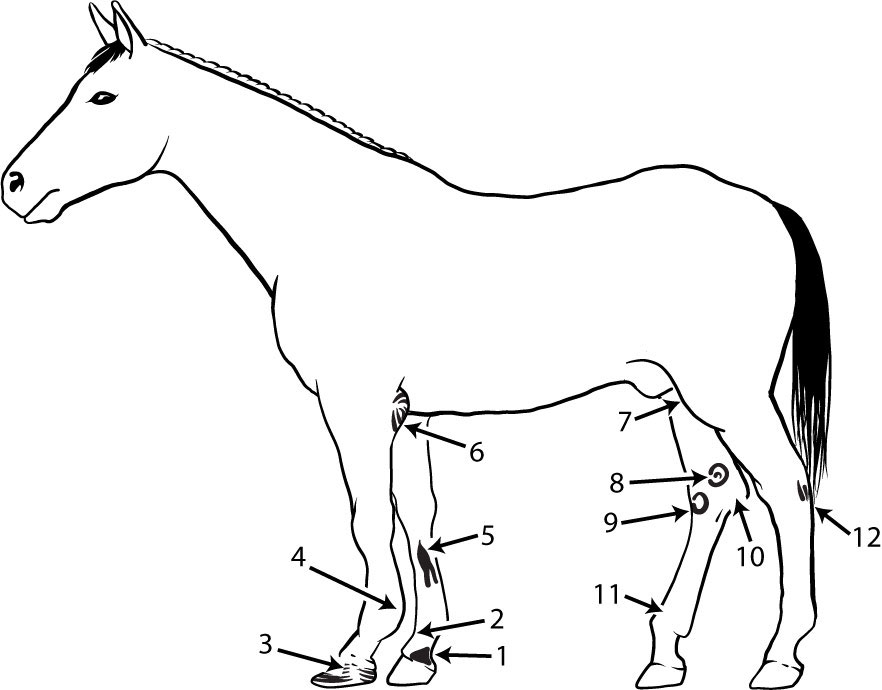
1. Sidebones
2. Ringbones
3. Laminitis (Founder)
4. Bowed tendon
5. Splint
6. Capped elbow
7. Stifled
8. Bog spavin
9. Bone spavin
10. Capped hock
11. Cocked ankle
12. Curb
Horse at work
Before you make a final decision about the horse, have it worked until it is warm. Notice its breathing. If it has respiratory illness or Recurrent Airway Obstruction (heaves or broken wind), you can spot it now. If it does not want to leave the stable and strongly resists or tries to bolt for the barn, it is barn sour. Barn sour horses would not be recommended for novice riders.
Watch the horse as it is ridden. Well-mannered and trained horses should not bite, buck, kick, rear, or bolt. They should display the following behaviors when cued:
- Proper leads should be taken when asked.
- The horse should stop collected on its hindquarters.
- Back readily with its mouth closed and head down when asked.
- It should ride around quietly with no tail wringing or head tossing.
- Movement should be free with plenty of flexion in the knees and hocks.
- The horse should be willing to accept pressure from the bit with a closed mouth and minimal resistance.
- Broke horses should not need to wear any correctional equipment (martingales, tie downs, drop nose bands or draw reins). These tools may be needed to prevent the horse from indulging in bad habits.
Ride the horse yourself but only after you have seen it be ridden by the seller. Keep in mind that most horses will not perform at their best for a stranger. It is ideal to ride the horse several times if you think that you would like to purchase it. When it becomes used to you and you both relax, you will be able to evaluate it more fairly.
Final thoughts
Be objective in your evaluation of the horses you are considering for purchase. If you have any doubts, look at more horses. No horse is perfect. However, the horse you select should not have faults that are dangerous to itself or to you. It should be sound and willing enough to perform the functions you require. Horse ownership should be a fun, family-oriented activity and it all starts with buying the right horse.
Additional University of Missouri Extension resources
To find a complete list of publications, videos, and other resources, go to the University of Missouri Extension website and search for Equine Extension.
- G2844,Haltering and Tying Horses
- G2864, Pre-Bit Hackamore Training
- G2870, Tips for Pony Pleasure Drivers
- G2878, Safe Ground Handling of Horses
- G2887, Selecting a Saddle
- G2881, Saddling, Bridling and Riding the Western Horse
- G2882, Safety for Hunt Seat Riders
- G2883, Intermediate Trail Riding
- G2884, Community Pleasure Trail Riding
- G2887, Selecting a Saddle